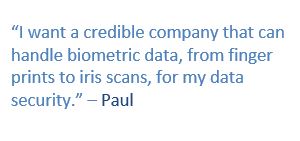
It has only been a decade since the 1st iPhone was launched, paving the way for smartphones and connected objects such as the smart watch with its many functionalities to become the most important devices in our lives. Today we stand on the cusp of another innovation that will impact our lives in many aspects from driverless transport to home automation and connected health. In a recent post, relying on the data from our consumer research, we looked into how we can meet their IoT expectations.
Now, let’s take a look into what consumers think about the personalization of services and data privacy.
Over the past 18 months, we have spoken to over 5,000 connected consumers to understand what they want from the IoT ecosystem for their connected future and to get some insight for stakeholders. Do you remember Emma and Paul? They are here to help us illustrate the findings and get a clear idea on what customers expect from the personalization of services and data privacy.

-
Personalization
Personalization is set to become key for both companies and consumers as data analytics mature and consumers become more amenable to sharing information for enhanced user experiences.
Attitudes towards private information such as of how, when and why users are contacted, as well as the sharing of location data, have evolved. People will share this data in exchange for personalized offers that deliver seamless and intuitive services. For example, Emma wants to be able to listen to music in her house while getting ready to go out, pause it as she leaves, and resume from exactly where she left off as she gets into her car.


Service personalization mandates that personal data is stored, processed and analyzed over time in order to deliver a better service for all users at every step of their daily activities. The type of private data could range from behavioral patterns, purchasing habits to biometrics data such as face, voice, finger print, etc. Currently this might mean that customers’ private information is processed by third parties. However, a significant percent of consumers (38%) still don’t want their data to be held by third parties citing security concerns. Nevertheless, personalization services like automatically displaying notification headlines and weather information on a wall, playing favorite music according to mood, etc., won’t be possible without the involvement of third parties.
-
Data privacy
For an end-to-end experience, private data needs to be transferred from and to different players. Data segregation is also a must, making sure that specific data is managed by authorized parties. As our report suggests, users don’t mind sharing information, as long as they control who has access to what and know that it is secure. The seamless experience must always go hand in hand with trust: enabling data segregation and storage, through digital security and also regulations controlling and enforcing data privacy.
-
Trust
In order to provide a truly-personalized experience, companies need to know more about their customers, and here we see something of a disconnect between what consumers want and what they are prepared to do for it. As mentioned earlier, more than a third of consumers still do not feel comfortable enough to share their personal data with third parties. Trust is increasingly important for users in a world where cyber-threats have become a constant part of the news agenda , with 37% of consumers considered to be ‘at serious risk’ of being hacked through their IoT devices, while their user journey is continuously evolving as new technologies and connected devices come to life.
Biometrics will certainly play a significant role in establishing trust as part of a seamless customer experience. Users care more about the efficiency of the service than how it works and would rather trust a credible security company to manage their private and personal data. In addition to this, in a case of a hack an effective customer service can establish trust between the compromised user and the service provider.
Consumers expect biometric techniques like fingerprint and facial recognition to become more widespread. Paul is one of the 70% of consumers that say they would be keen to use their smartphones as digital identity documents if robust security measures were in place.
Today consumers already share their private data through social media and online retailers. For instance, they are going for personalized services provided by key online retailers such as Amazon and eBay promoting personalized services based on consumers purchasing patterns and preferences. The connected devices that exist today have been developed to include biometric recognition – just look at Google and Amazon’s smart home devices with voice recognition, Apple’s new iPhoneX facial recognition, and the mass adoption of the fingerprint. Biometric recognition is an input for personalization and the consumer demand for seamless and personalized experience will continue to rise as long as expectations and concerns regarding data privacy are managed.
How do you feel about sharing your data with third parties in exchange of personalized experience? Let us know by leaving a comment below or tweeting to us @Gemalto.




